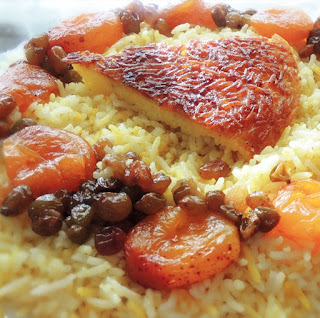Okroshka is a cold soup cooked with meat, vegetables and Russian national beverage kvass. This dish is unique; there are no similar dishes in the world. Only Spanish gazpacho is a little bit like Russian okroshka, but the list of ingredients is strongly different. We often call Okroshka as “summer soup”, because it is good in Summer. Sometimes in Russia, they add pieces of ice to keep it cold. This dish will refresh you in the hot weather. The name “okroshka” originates from the Russian verb “kroshit” translates as "to crumble" that means to separate something into little pieces. The dish was always a way of utilizing any foodstuff left from other dishes, especially meat. If you have a few pieces of meat, then the best idea to use it somehow will be cooking okroshka. It is delicious, easy and fast to prepare.
Russian Gourmet Cuisine - Русская Кулинария
Russian Cuisine and Holistic Nutrition - Русская Кулинария и Здоровое Питание
Sunday, September 13, 2015
Red Borsch – Красный борщ
Red Borsch is the most well-known
Russian dish in the world.
Borsch derives from a hogweed soup
originally made by the Slavs
way before they separated in 16 century. Modern borsch typically made with meat
stock and sautéed vegetables such as beetroots, white cabbage, carrots, parsley root, potatoes, onions, and tomatoes.
There are three basic types of
borsch red, green and the original (plain borsch).
The red borsch considered being a
winter dish. The preparation of beetroot, proper for genuine red borscht, is
the special process with a strict technology. A beetroot should be stewed in
sunflower oil. Some cooks prefer to add vinegar or lemon acid.
The main ingredients for green
version or the dish are greens. It is usually cooked during spring and summer
seasons and served hot or cold with optional hard-boiled egg and sour cream.
The plain borsch is a simplified
version of the red but without the beats often substituted with sauerkraut.
Golubtsy - Голубцы
Golubtsy represent a mix of rice and mincemeat wrapped inside cabbage leaves. The cooking process takes about 2 hours.
Technically everything wrapped in a cabbage leaf (fresh or sour) in Russia is called golubtsy. That said the dish could be vegetarian as well. We are cooking a non-vegetarian version of golubtsy.
The word "golubtsy" originates from the Russian word “golubyj”. This word is old and nearly forgotten. Few derivatives are still in use in the modern Russian language: Golubchik – a gentle appeal to a male. Golubushka - a gentle appeal to a female. The word “golubyj” translates as “tender” or “gentle”. The word “golubets” rather referred to “a gentle dish”.
Technically everything wrapped in a cabbage leaf (fresh or sour) in Russia is called golubtsy. That said the dish could be vegetarian as well. We are cooking a non-vegetarian version of golubtsy.
The word "golubtsy" originates from the Russian word “golubyj”. This word is old and nearly forgotten. Few derivatives are still in use in the modern Russian language: Golubchik – a gentle appeal to a male. Golubushka - a gentle appeal to a female. The word “golubyj” translates as “tender” or “gentle”. The word “golubets” rather referred to “a gentle dish”.
Pilaf Uzbek, Azeri, Russian" / Плов Узбекский, Азербайджанский и Русская кутья
 |
| Азербайджанский Плов |
Though you’ll now find numerous versions of pilaf throughout the world, food historians often date pilafs back as far as about the 5th century BCE.
It is believed that the proper preparation of pilaf was first documented by a tenth-century scholar named Avicenna (also called the "father" of modern pilaf),. In his books on medical sciences Avicenna dedicated a whole section to preparing several types of pilaf.
 |
| Плов Узбекский |
 |
| Русская кутья |
Vinaigrette / Винегрет
Vinaigrette is just as famous as stolichni salad although it is a completely different dish. It is always vegetarian and has beets and
various beans along with sauerkraut and greens.
In Russia and other post-Soviet states both salads are among the main appetizers served during New Year's Eve ("Novy God") celebrations.
In Russia and other post-Soviet states both salads are among the main appetizers served during New Year's Eve ("Novy God") celebrations.
Salad Olivier - Столичный салат
Olivier Salad is known in many countries,
often under the name of Russian salad, not only in the countries of the
former USSR but also in Bulgaria, Serbia, Greece, Croatia, Spain,
Poland and even Argentina and Uruguay. It first appeared in the Russian
magazine Наша пища in1894).
It is usually made with diced boiled potatoes, carrots, brined dill pickles, green peas, eggs, celeriac, onions, diced boiled chicken (or sometimes ham or bologna sausage), tart apples, with salt, pepper, and mustard added to enhance flavor, dressed with sour cream/ mayonnaise..
It is usually made with diced boiled potatoes, carrots, brined dill pickles, green peas, eggs, celeriac, onions, diced boiled chicken (or sometimes ham or bologna sausage), tart apples, with salt, pepper, and mustard added to enhance flavor, dressed with sour cream/ mayonnaise..
Subscribe to:
Comments (Atom)




